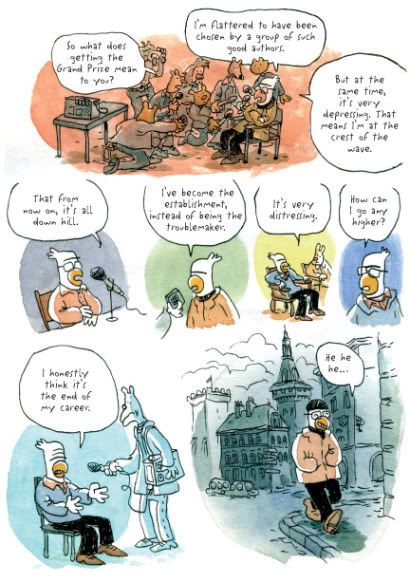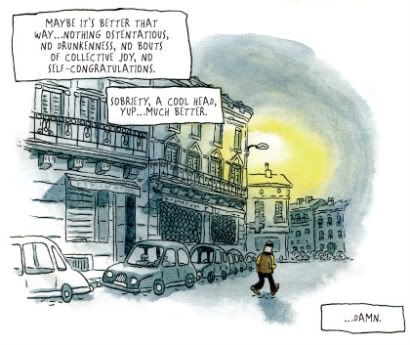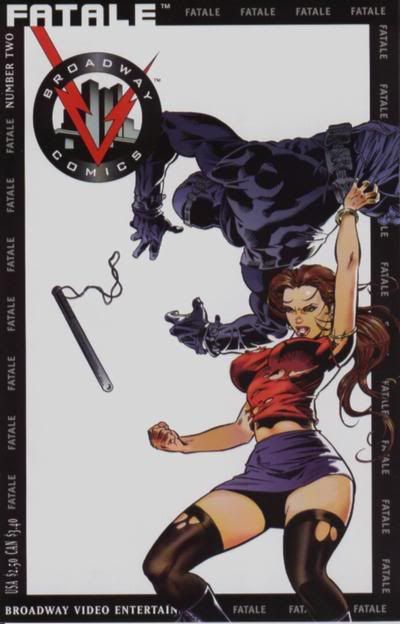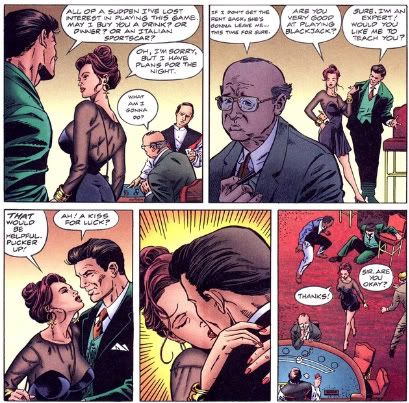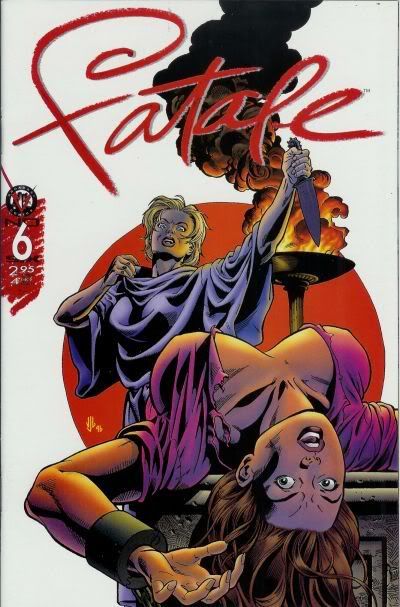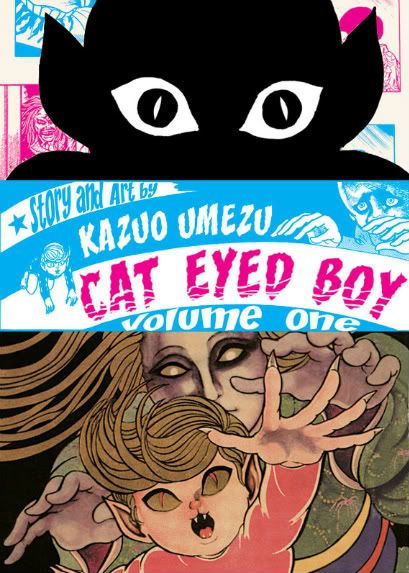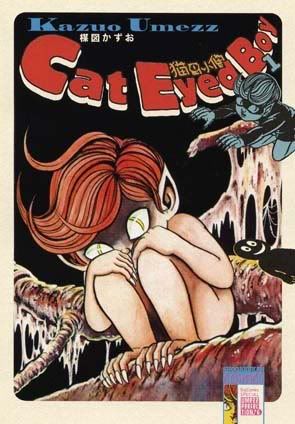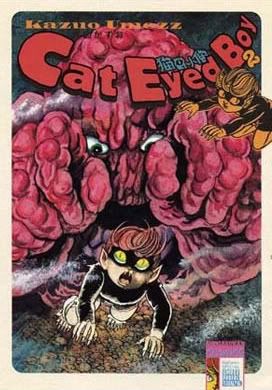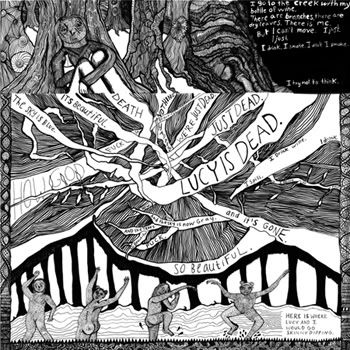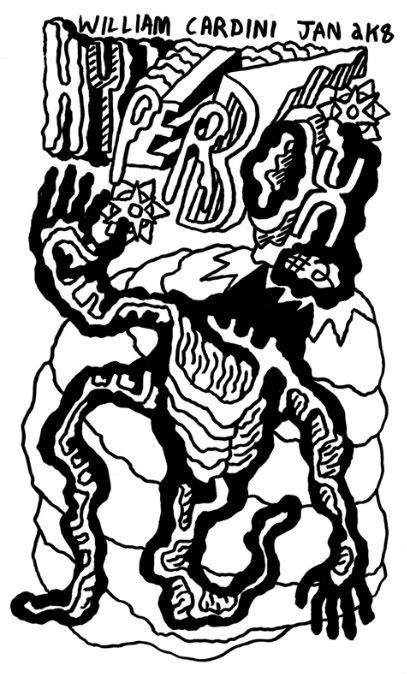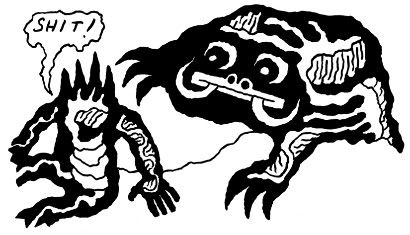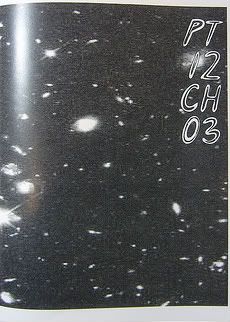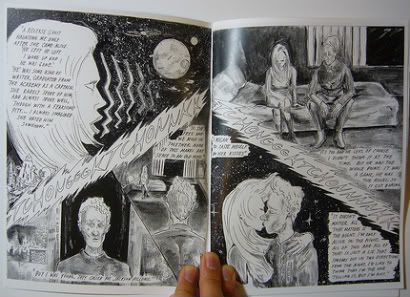Batman: Gotham Knight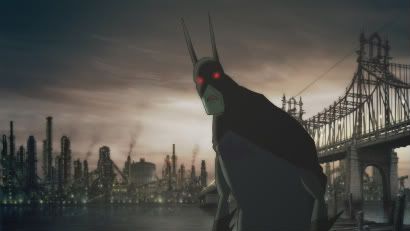
This is a new, 76-minute anime OVA, just released today to R1 dvd. It's an anthology of linked Batman stories, poised as a tie-in to some movie that's coming soon. It's sort of ok, sort of boring, kind of striking at times, sometimes unimpressive. It might be worth renting; even $13.00 or so to own the one-disc edition seems too much.
It probably wasn't hard to sense trouble brewing. The project was announced before any specific animators were attached by name, although the involvement of three major anime studios was noted: Production I.G., Madhouse, and Studio 4°C. Rumors swirled of participation by directors like Satoshi Kon (
Paranoia Agent,
Paprika) and Masaaki Yuasa (
Mind Game,
Kaiba). Eventually
a press release arrived, and there were only five directors named for six segments.
Information dribbled out as the release date drew near. It turned out the three studios weren't doing two shorts each - I.G. had only completed one, with another handled by its former subsidiary Bee Train, a studio notorious as a type of junior varsity team for young animators, often producing just the results you might expect. A
well-placed source claimed that one of Madhouse's segments had been sort of taken on by 4°C after an unnamed initial director left the project. And the case of the missing director grew much
darker when it was revealed that the pertinent segment had the names of
everybody in its primary animation crew omitted from the credits.
Yikes.
I don't know what really happened, although I
do know that these American-Japanese animation projects tend to be difficult. And I don't mean low bid jobs for US-targeted cartoon shows like back in the day - I'm talking about the caretakers of a major entertainment concern from one culture dealing with the autonomous animation traditions of another, both forces used to calling the shots and getting things done
their way.
The very model of such a contemporary project remains 2003's
The Animatrix anthology, which saw the desires of often-idiosyncratic Japanese directors bump into the franchise vision of
The Matrix. Not that some good things didn't happen (some of them better than the proper Matrix sequels) - hell, my favorite of those shorts was 4°C co-founder Koji Morimoto's (the one with the glitchy 'haunted' house), allegedly the result of struggle and compromise between Morimoto and the Wachowski brothers.
And things seemed even hairier on 2007's feature-length
Highlander: The Search for Vengeance, with director Yoshiaki Kawajiri (he of
Ninja Scroll fame) making various and sundry unilateral changes the American script; in the end, the US producers recut the auteur's final product for the version that saw release.
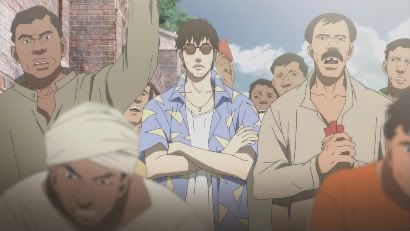
The present project is top-heavy with Western talents, from Bruce Timm as executive producer down to the assorted screenwriters, filled with animation, movie and comics veterans. Don't look to the dvd's supplements for guidance on the Japanese (you know,
animation) side of things - the second disc of the deluxe edition somehow manages to get through two and a half hours of stuff without so much as a
mention of the Japanese staff. You get four episodes of
Batman: The Animated Series, a remarkably tedious documentary on the Batman rogues gallery and a fitfully interesting video biography of Bob Kane, which does at least
try to hit the unsavory bits of his life in the process of stuffing it into a Charming Rogue Finds Redemption narrative. More than once an art sample seems to hang on a detail of Bill Finger's story credit, as if in apology.
The main disc has a spotty, mostly uninteresting audio commentary by DC Senior VP/Creative Affairs Gregory Noveck, longtime Bat-family writer/editor Dennis O'Neil and voice actor Kevin Conroy - at least they talk a little about the animation, if only in broad expressions of praise for everyone's hard work. But mainly the package seems focused on promoting the Batman
brand above anything specific, and it thereby fails to overcome the impression of a mercenary big media tie-in; granted, that's what The Animatrix was too, broadly, but at least
it made an effort to tour the animation approaches at work, really giving off some enthusiasm as a worthwhile standalone project.
This? You'd swear it was plain Bat-product. It feels like it sometimes. Let me go bit by bit.
Have I Got a Story For You 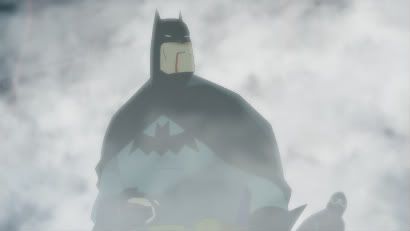
All the stories in
Batman: Gotham Knight are connected; it must have been a chore getting all these animation studios to hew to the connecting story fiber. Some differences were inevitable -- especially visual ones -- so this story (scripted by Josh Olson of
A History of Violence) serves as sort of an overture, being a new take on the old scenario of everyone telling ultimately-connected stories about wildly different versions of Batman. It makes more sense as the plot of a short cartoon - the project's megastory is barely noticeable, and culminates in nothing whatsoever. Was Warner Brothers nervous with the idea of an anthology all of a sudden?
Ah well, at least it's an opportunity for Studio 4°C to strut its stuff. The director is Shojiro Nishimi (also animation director), who served as animation director/character designer on 4°C's 2006
Tekkonkinkreet theatrical feature. It looks and feels quite similar to that work, squat and plump personages abounding, although the storyboards, character designs, staging & layouts, art direction
and animation supervision is the work of Shinji Kimura, Tekkonkinkreet's art director and a segment director on 4°C's
Genius Party anthology.
A lot of fun is had with the various versions of Batman -- a shadow monster, a flying beast, a mighty robot -- with the action moving methodically across the expected expressive urban detail. This is the only segment to work its title into the action itself, which says something for the level of decoration involved. The chunky True Batman seen above maybe also says a little for the lack of slam-bang action - this is more a
dancing thing, kids wobbling on their skateboards and far more interest aroused by someone in the background losing their footing when Robobat deflects a laser blast. Lots of visual nuance.
Lots of work too, I expect; judging from the credits on its two official segments, 4°C seems to have employed one-fifth the population of Japan as in-betweeners. Such inclusion!
Crossfire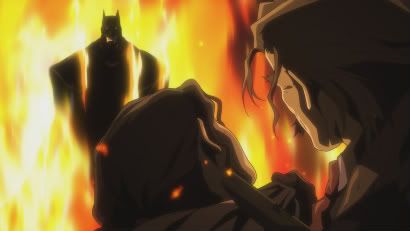
And then, my hopes came crashing down. This is just
boring, which I sure wouldn't have expected from Production I.G.'s only segment of the project, one written by the very capable Greg Rucka. But this is as dull and simplistic as a talk-heavy Batman story can be - Cop #1 doesn't trust Batman while Cop #2 does, but then they get caught up in a deadly crime event which is resolved by Batman hitting things until justice wins. Then Cop #1 likes Batman. Yay!
Writing aside (and keeping in mind that the 'writing' can always change on the way to the screen), this is maybe the dullest piece of animation I've seen out of I.G. in a long while. Director/Storyboardist Futoshi Higashide (whom I've never heard of; he was an animation director for some 2007 feature titled
JAPAN, Our Homeland) and Animation Director/Character Designer Shinobu Tagashira (of the
Hunter X Hunter franchise) bring no innovation or interest to long scenes of chit-chat, relying exclusively on a neon carnival background vision of Gotham to keep the viewer's eyes open. The concluding action scene does snap things to attention a little bit, but it's not long enough to act as an impressive set piece; it seems
inevitable, like even its novel motions are so directed by formula that they can't impress.
It's like a throwaway backup story in an Annual, or a fill-in episode of a television series or something. So unremarkable it can be plugged in anywhere, anytime, if something better can't be found, which isn't the best feeling to present when getting to the meat of your anthology's content. What a waste.
Field Test 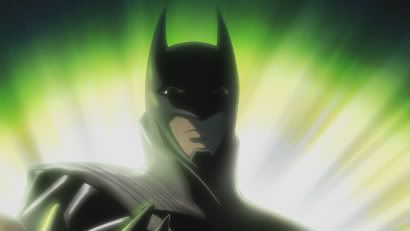
Seriously though, if you'd come up to me last week and said that fucking
Bee Train's entry would top the work of I.G. proper, I'd have laughed (then probably asked who you are). But look what's happened.
This is probably the most 'traditionally' anime-styled of all the segments; the director/animation director, Hiroshi Morioka (co-director of the second season of the
Tsubasa: RESERVoir CHRoNiCLE televisions series) is probably a competent enough craftsman, although this is the only work of his I've seen. The star of the show, however, appears to be Toshiharu Murata, character designer and co-animation director of the
Hellsing television series, who serves here as storyboardist, character designer and, apparently,
sole key animator. If those credits are right, this is impressive work - not outstanding, or even particularly
inspired to my eye, but steady and on-the-level in visual quality.
The script (by Jordan Goldberg) is a showcase for Batman's relationship with his gadgets; Goldberg is also credited with the "
story" for many of the project's segments, so it's probably unsurprising that a good deal of time is spent toying with plot strands that only get picked up elsewhere in the OVA - given the lack of impact for all that, it seems like time that could have been better spent teasing out the psychological implications of Our Hero's gear, an interesting enough tact that winds up getting limited play. Really, I can't say this is all that effective a short on any level, not on the whole, but at least it has a decent ring of technical victory.
In Darkness Dwells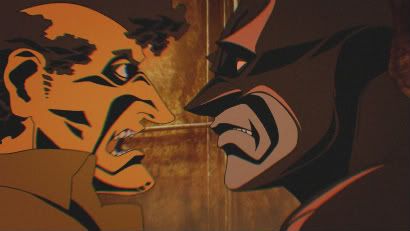
I really like this episode's director (and animation director, and storyboardist), Yasuhiro Aoki. He's directed a few episodes of Studio 4°C's oddball kiddie tv series
Tweeny Witches, but I know him best for the wonderful 4°C
Amazing Nuts OVA anthology short
Kung-Fu Love. This is the Madhouse short that 4°C supposedly worked on a lot after the first director left; I notice there's an official "
co-director" credited (Yuichiro Hayashi) with character designs and art direction by Kaoru Inoda, who's notable for having worked as a background artist or art director on
three of Satoshi Kon's projects. The production coordinator is Toyoo Ashida - holy shit, is that the same guy who directed
Vampire Hunter D and
Fist of the North Star?!
It's a strange, slow-building piece (script by David Goyer), with brief, spooky appearances by Scarecrow and Killer Croc, and much of its energy spent on rotten sewer atmosphere. Batman is pumped full of hallucinogenics (how current!) and swings around flying scythes in a slow, hellish collapse of stuff. All mood. Maybe the result of picking up after a broken-down start? Good anyway.
Working Through Pain 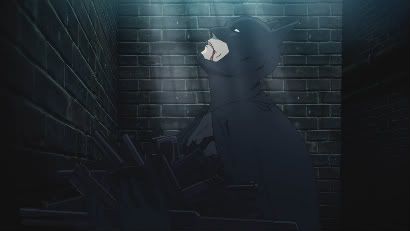
On the other hand, this is probably the most ambitious of the shorts in a storytelling sense; it's the other official Studio 4°C segment, with a script by Brian Azzarello, who follows up the preceding short with a long, bloody trudge by Batman through the sewers, flashing back to his education in the ways of putting the pain away, at the hand of a young Indian woman with trouble in her own background.
Philosophy is doled out, meditations are undergone, and things, unfortunately, get kind of silly by the time Young Master Wayne saves the woman from local toughs by standing around and letting guys break wooden boards and glass bottles over his head, because he can just ignore the hurt, man - no word on the metaphorical quality of his presumably cast-iron skull, or if he can move past the concussion as well. Yet Batman's success dooms him to the shadows - it all ends in a scene of the Dark Knight frantically gathering stray guns in his arms, leaving him
unable to accept the hand of aid.
I mean, points for effort, hell yeah, but this got too rich by half for me.
It's an old-timey romp on the animation front, with direction and animation direction by Toshiyuki Kubooka (chief animation director of the classic
Gunbuster) and character designs by Naoyuki Onda, an old hand animation director/character designer with credits dating at least as far back as
Mobile Suit Zeta Gundam in the mid-'80s. The "
storyboard supervisor" and "
conceptual design" credits go to Tatsuyuki Tanaka, another Genius Party fellow. It's very pretty, very classy, and of a softer touch than the writing it has to work with; it calms a little in that way.
Deadshot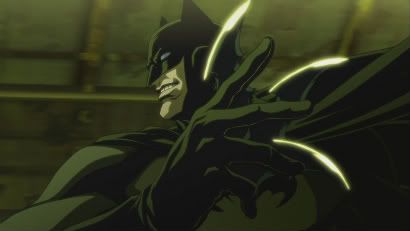
And finally -- oooooooh! -- the
mystery segment! Directed by Edward Nigma! Storyboards by Matches Malone! Actually, there
is a credited director of sorts, one Jong-Sik Nam of Dongwoo Animation ("
executive director" of the 2001 South Korean tv animation series
BASToF Syndrome), albeit under the omnious heading of "
Additional Animation Services By" - all the animation that isn't 'additional' is credited collectively to Madhouse, which didn't seem to have an easy time at all with this show.
Still, some clues as to the primary animation crew can be discerned from the segment's visual... you know what? Fuck it. This thing looks a
lot like the work of the aforementioned Yoshiaki Kawajiri, of that troubled Highlander production (and an Animatrix episode too). And he doesn't exactly have an orthodox visual approach either - the long faces and sculpted muscles and swooping action and flamboyant costuming and cheeseball visual grandeur of this segment all but
scream Kawajiri, a Madhouse stalwart whose work remains remarkably constant across various character designers and art directors.
Sure, it could be someone else doing a loving homage to Kawajiri, their hero. Maybe it was all an elaborate apprenticeship for some young successor. Maybe the credits are misleading, and Jong-Sik Nam really called all the shots (at Madhouse, a studio I don't believe he's ever worked for). Maybe Warner Brothers demanded something that looked like Ninja Scroll, and nobody wanted to fess up to the emulation. Maybe Haruhi Suzumiya took over. Ooh, maybe Batman is
real, and
he directed the episode!! That would be great. "
Directed by Batman."
But whatever happened, and whomever it happened to, there's a funny thing about it:
Deadshot, minute-for-minute, is probably the most entertaining thing on this disc. It's fast, it's simple, it's faintly ridiculous and
glad about it - it's basically Batman vs. Golgo 13, if G13 was a sneering, monocle-wearing playboy with wrist-mounted machine guns tucked under his red pimp outfit. Everyone on the audio commentary seems agog at what's happening on screen; I just wished there was more of it. More absurd Bat-fun, with loud villains pulling off wild stunts and Bruce Wayne hitting things in style.
It's a preference among Bat-simplicities, I guess, and it sure helps that the animation plays out in that bulky, trapped-in-'93 style - it still speaks to me, when I want to hear bullshit. I wonder how much of a compromise this episode was. Which direction did Alan Burnett's script go in? What happened to cause all the names to vanish? Which tipping point am I smiling toward? Any?
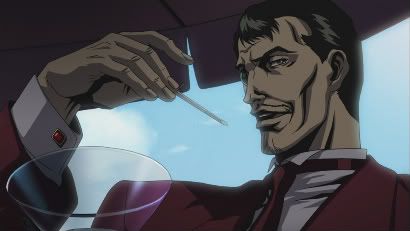
Warner Brothers isn't talking, not in any iteration this package. And no, I don't
expect a studio to talk about all the production headaches that go into a major project, particularly a work of animation.
Yet, the whole 'animation' things seems so elusive in the presentation. So
optional. Forgive me if I read too much into it, but this dvd seems franchise-focused to the point of dehumanizing the people that made it all move. In a way, that's rather 'modern anime' of it - I doubt I'll ever read as much about this thing online as I will any popular cartoon show on Japanese television right now, since... er, you have to
pay for this, and so much of today's anime fandom is based around piracy. Not just sampling - a generation of viewers that don't see the need to give money, that often don't know of the people that make these shows, that
consume. Like the stuff always existed, and always will.
That's the sense I get of Batman on discs like this. Character over creators! A superhero classic, and maybe, in the little world of anime, a certain queasy encouragement. But watch out for the results, caretakers of a major entertainment concern.
I'm
sure Warner Brothers doesn't want anyone to stop buying stuff.


